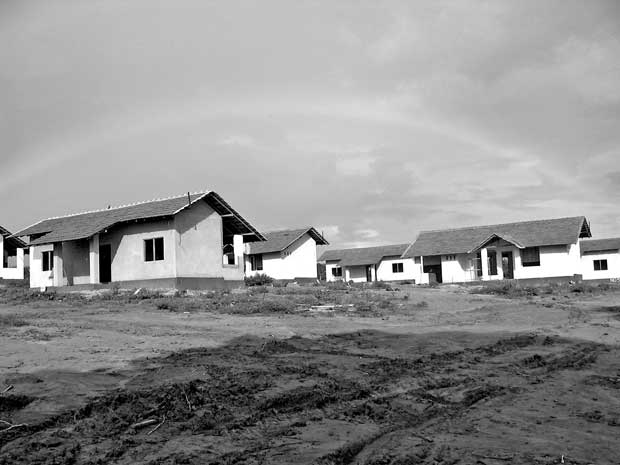Reply To:
Name - Reply Comment
Last Updated : 2024-04-25 20:04:00

These communities have depended on meagre savings, remittances and humanitarian relief as the local economy centred on agriculture and fisheries ground to a halt during the war.
Eight years after the end of the war, the rural economy in the North is still in crisis. Fisheries and agricultural incomes are falling, employment opportunities are few and crippling indebtedness is pervasive. It is in this context that these rural communities are seeking decent housing to nurture their families, protect themselves from floods and further displacement, and secure a landed asset that can be passed on to the next generation. 
With post-war reconstruction efforts focused on building infrastructure such as roads, and little done to rejuvenate production, it is the various housing schemes that have provided some stimulus to the local economy. In many cases, however, these schemes have also increased household debt as housing grants of Rs. 325,000 and Rs. 550,000 from the World Bank and Indian Housing Schemes, respectively, fell short of what was needed to build the structures specified by the implementing agencies. Yet, these housing schemes created livelihood opportunities for large numbers of masons and wage workers, many of whom could not earn a living from agricultural and fisheries work. And now that minimal form of economic stimulus is also at risk with the Government’s moves to consider importing 65,000 prefabricated steel houses as opposed to building locally proven brick and mortar houses.
As the economic crisis in the war-torn regions deepened, regime change in 2015 brought some hope for revamping the failed reconstruction measures. While the first Budget of the new Government for 2016 included little by way of allocations for reconstruction, apart from the allocation for 10,000 houses to be built by the Resettlement Ministry, there were two major announcements by the Government at the time of unveiling that Budget. First, the Government planned for a donor conference in Tokyo in June 2016 to raise funds to reconstruct the North and East. Second, the cabinet decision to build 65,000 houses in the North and East.
The Tokyo Donor Conference seems to have been a pipedream of the Government as it was quietly  buried in 2016. The 65,000 houses on the other hand led to a fierce debate. The Government came under serious scrutiny as it attempted to import prefabricated steel houses unsuitable for the local environmental and social conditions, at a high cost of Rs 2.2 million each and a massive internationally financed dollar loan of US$ 1 billion. There have been accusations in parliament that the housing project was in fact a prefabricated deal on the number of houses and to whom the contract would be awarded.
buried in 2016. The 65,000 houses on the other hand led to a fierce debate. The Government came under serious scrutiny as it attempted to import prefabricated steel houses unsuitable for the local environmental and social conditions, at a high cost of Rs 2.2 million each and a massive internationally financed dollar loan of US$ 1 billion. There have been accusations in parliament that the housing project was in fact a prefabricated deal on the number of houses and to whom the contract would be awarded.
The Government’s duplicitous approach – of raising expectations about massive funds for reconstruction through the Tokyo Donor Conference, and even worse blackmailing the war-torn people that it would be either prefabricated steel houses or nothing – is abominable. There are as many as 130,000 households in the North and East that qualify for the housing schemes and are still waiting to rebuild their lives after the war. Furthermore, tens of thousands of people, from perhaps the most marginalised classes in the war-torn regions, do not even qualify for such housing grants because they are landless. In the Jaffna District for example, there are 14,000 families making up about 10% of the population who are absolutely landless.
Even as the economic crisis deepens in the war-torn regions, the two years after regime change have been valuable time lost for reconstruction. The donors have little interest now in reconstruction, much less building houses, as they are preoccupied with conflicts and crises in other parts of the world. And it is the Government that is responsible for reconstruction, but even on issues of housing and landlessness, the Government is failing.
As the 65,000 housing controversy mounted in 2016, the Government claimed there was no alternative. A group of us, including architects, researchers, housing professionals and activists wrote an extensive alternative proposal, which highlighted the major environmental, social and economic short-comings of the prefabricated housing scheme and the tremendous gains from the proposed alternative of building brick and mortar houses. While the 50 page proposal submitted to the Government a year ago addressed these concerns extensively, some of the economic benefits in the proposal alone are discussed below.
While the Arcelor Mittal houses were billed at close to Rs 2.2 million each, the alternative proposal showed that Rs 1 million would be adequate to build a house and even provide some additional services and community infrastructure. Like the Resettlement Ministry’s successful 10,000 houses at Rs 800,000 each last year, the same amount is sufficient to build the house, but the additional Rs 200,000 would ensure other needs such as electricity connectivity, water and drainage infrastructure, rural lanes and some community facilities.
The alternative proposal highlights major economic gains. An expression of interest from a national development bank provides for financing the housing scheme through rupee bonds in the local capital markets. In comparing the internationally financed US$ 1 billion Arcelor Mittal project loan to the locally financed rupee bond loan, the proposal illustrates tremendous savings for the country. For the same present value of both loans – that is adjusting for the foreign currency exchange rate and differences in interest rates – about 102,000 brick and mortar houses can be built for the price of importing 65,000 prefabricated steel houses. The Government does not need yet another massive dollar loan, the cause of balance of payments problems for successive governments. In other words, paying back the Arcelor Mittal loan amounting to US$ 1 billion will require valuable foreign exchange, but the local loan can be paid back in rupees, relieving external financial pressures on future governments. Even as falling foreign reserves led to the June 2016 IMF agreement providing Sri Lanka a loan of US$ 1.5 billion along with stringent conditions undermining social welfare, the Government is considering paying a foreign company US$ 1 billion!
Above all, the alternative proposal will result in the expansion of local livelihoods. The imported prefabricated steel houses provide next to nothing in local incomes. However, each brick and mortar house will provide direct labour incomes of Rs. 250,000, that is, on average, a local mason’s yearly income. Furthermore, additional employment will be created with the production of house fittings such as wooden structures, plumbing material and roofing. Such economic stimulus with incomes for tens of thousands of workers and demand for local production is a dire economic need in the North and East.
Given the robust economic benefits to both the country and the war-affected people from the alternative proposal, the Government’s insistence and repeated efforts to push forward the Arcelor Mittal project is reprehensible. Pushing through massive development projects, seeking enormous profits for multinationals who have the political elite in their pay while undermining people’s wellbeing, after tremendous human and natural tragedies is characteristic of neoliberal disaster capitalism. In any event, the alternative proposal has been extensively discussed with Government Ministers and officials and was even tabled in parliament. So the Government is running out of excuses. The Northern Provincial Council’s (NPC) inaction and even blocking of development is rightly the talk of the town in Colombo policy and diplomatic circles. However, in recent months, the NPC’s bankruptcy have become a convenient excuse for the Government’s major failures at post-war reconstruction. The lack of allocations for reconstruction of the Northern and Eastern Provinces in the two recent Budgets, and the Tokyo Donor Conference to initiate a new phase of reconstruction that was never to be, are much larger failures for which the Government is directly responsible.
Forty years ago, J. R. Jayewardene in promoting the open economy and inviting cut-throat international financiers famously said: “Let the robber barons come!” In happily importing multinational products, including houses that have been locally produced for ages, this Government seems to be taking its forefather’s message to heart. The billion dollar question is whether this broad daylight housing robbery will only benefit a multinational robber baron or whether there are local robbers who
stand to gain?

Add comment
Comments will be edited (grammar, spelling and slang) and authorized at the discretion of Daily Mirror online. The website also has the right not to publish selected comments.
Reply To:
Name - Reply Comment
US authorities are currently reviewing the manifest of every cargo aboard MV
On March 26, a couple arriving from Thailand was arrested with 88 live animal
According to villagers from Naula-Moragolla out of 105 families 80 can afford
Is the situation in Sri Lanka so grim that locals harbour hope that they coul